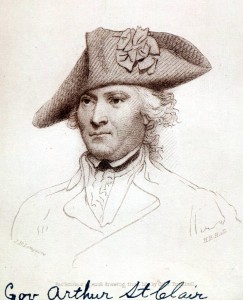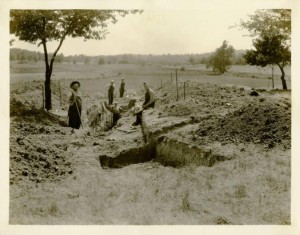“Seeking Site of Fort Jefferson”

In the long life of the Ohio Historical Society–we will turn 130 years old next year!–the organization has continued to expand its reach throughout the state by incorporating historic sites that tell the stories of Ohio’s past. One of those sites, now known as Fort Jefferson Memorial Park, underwent an in-depth exploration back in the late summer of 1930 that added significantly to our knowledge of and collections from the area.

A recently added item on Ohio Memory, with the title “Pictorial Record of Archaeological Explorations Employed in Definitely Locating Fort Jefferson During July and August, 1930,” gives users a unique behind-the-scenes view of the excavations that took place on the site at this time.
Built about six miles south of Greenville, Ohio, in October 1791, Fort Jefferson was originally meant to serve as a supply garrison for Arthur St. Clair’s campaign against the area’s Native American population (hence its original name–Fort Deposit). In November of that year, St. Clair attacked the local Indians, but under the leadership of Blue Jacket and Little Turtle, the Miami tribe easily defeated St. Clair and his troops. This loss, one of the worst for the American military at the hands of the Native Americans,came to be known as “St. Clair’s Defeat,” and during the battle well over half of St. Clair’s1,400 men were killed or wounded. After the battle, St. Clair’s men fled to Fort Jefferson, but found little in the way of supplies and quickly moved south to Fort Washington. Fort Jefferson’s supplies were later used during the campaign of “Mad” Anthony Wayne, before the fort was abandoned in 1796.

While the fort itself is no longer standing, a 1907 memorial marks this important location that was acquired as an OHS site between 1928 and 1931. The 1930 excavation efforts were performed under the direction of H.R. McPherson, of what was then the Ohio State Archaeological and Historical Society, and Frazer Wilson, of the Greenville Historical Society. Using what McPherson called “modern archaeological tactics,” they hoped to find the exact location of the former fort. Nearly a century and a half after its destruction, no surface traces were left of the structure, but careful excavation turned up clues on the fortification’s various features, including the blockhouse, stockade, magazine, water source and more. The physical artifacts found during the exploration included remnants of military uniforms, materiel and ammunition, and more; these were divided between the collections of the Ohio Historical Society and the Greenville Historical Society.
We invite you to look over this pictorial record of the excavation, as well as additional Fort Jefferson materials available on Ohio Memory. Stay tuned to the OHS Archaeology blog, Natural History blog and Collections blog in the coming weeks for an ongoing series about the archaeological exploration of the fort, and what interesting things were discovered at this important site!
Thanks to Lily Birkhimer, Digital Projects Coordinator at the Ohio History Connection, for this week’s post!



Leave a Reply
You must be logged in to post a comment.